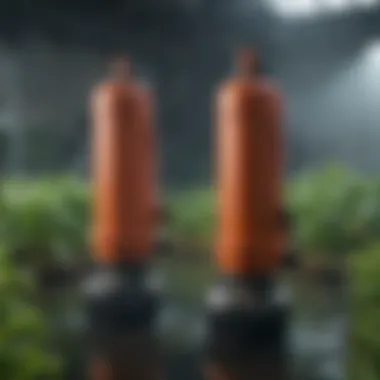The Essential Role of Submersible Water Pumps in Hydroponics


Intro
Submersible water pumps are a crucial component in hydroponic systems. These systems aim to grow plants without soil, relying on nutrient-rich water solutions. Understanding the role of submersible pumps is essential for both novices and experienced hydroponic farmers.
The primary function of these pumps is to move water efficiently from a reservoir to the plants. This process ensures a consistent supply of nutrients and oxygen. The correct pump can significantly affect plant health and growth rates. Furthermore, selecting the right pump is influenced by several factors, including the system's design, plant types, and scale of operation.
This article seeks to explore the various dimensions of submersible water pumps within hydroponics. We will analyze current trends, best practices, pest management strategies, and more. Let's begin with the research and data analysis related to the usage of these pumps in modern agriculture.
Research and Data Analysis
Latest Trends in Agriculture and Horticulture
The integration of technology in agriculture is transforming traditional farming practices. Submersible water pumps are at the forefront of this change, especially in hydroponics. Modern hydroponic systems are increasingly relying on automation and efficient irrigation techniques. Data from various sources suggests that farmers are adopting hydroponic systems to streamline crop production and reduce resource waste.
The growing interest in sustainable practices has also led to advancements in pump technology. Innovations focus on energy efficiency and durability, making these pumps more reliable for long-term use.
Statistical Insights into Crop Yields
Research indicates that hydroponically grown crops can yield significantly higher than conventionally grown plants. For instance, a study highlighted that lettuce grown in hydroponic systems can have yield increases of up to 30% compared to soil methods. Moreover, these systems often require 90% less water than traditional agriculture practices.
"Submersible pumps play a vital role in ensuring that nutrient delivery systems operate optimally, thus enhancing overall productivity."
The data shows a positive correlation between well-maintained submersible pump systems and higher crop yields. Thus, optimizing pump performance becomes critical for maximizing hydroponic success.
Best Practices and Techniques
Efficient Crop Management Strategies
To achieve the best results in hydroponics, applying efficient management techniques is essential. Regular monitoring of water quality and nutrient levels is crucial. Using submersible pumps allows for precise control over these elements.
Farmers should also consider the pump’s flow rate and pressure. Matching these parameters to the specific needs of the plants can lead to better growth and healthier crops. Regular pump maintenance can prevent failures and ensure consistent delivery of water and nutrients.
Sustainable Horticultural Techniques
Sustainability is central to modern agriculture. Hydroponics offers an opportunity to minimize environmental impact while maximizing productivity. Using submersible pumps, hydroponic systems can recycle water efficiently. This reduces waste and conserves resources, a critical concern in today’s context of climate change.
Employing organic nutrients further enhances the sustainability of the system. Combining these practices can result in a well-rounded, eco-friendly approach to farming.
Pest and Disease Management
Common Pests and Diseases in Crops
Hydroponics systems, while less prone to certain pests than soil-based systems, are still vulnerable to specific threats. Common issues include aphids, spider mites, and root rot. Effective monitoring and timely intervention are key to managing these challenges.
Integrated Pest Management Strategies
Adopting an Integrated Pest Management (IPM) approach is beneficial. This strategy combines biological control, cultural practices, and the targeted use of pest control products. Maintaining a clean environment and ensuring proper plant spacing can reduce pest incidence.
Using submersible pumps allows for the incorporation of preventative measures, such as circulating beneficial organisms or applying organic pesticides through the water system.
Prelude to Hydroponics
Hydroponics stands as a revolutionary approach to agriculture that bypasses traditional soil-based growing methods. This introduction sets the stage for understanding the role submersible water pumps play in hydroponic systems. Hydroponics allows for efficient resource management and improved crop yields.
The central concept involves growing plants in nutrient-rich water solutions. This method not only conserves space but significantly reduces the amount of water needed compared to conventional farming practices. By focusing on the essential needs of plants, hydroponics can yield higher quantities while using fewer resources. Such efficiency is especially critical in urban areas where space is restricted and water sources are limited.
Importance of Hydroponics in Modern Agriculture
Hydroponics has gained traction due to several pressing challenges in agriculture today. With the global population rising, there is an increased demand for food production. Hydroponics offers a sustainable alternative to tackle food security issues while minimizing environmental impacts.
In addition to the aspects of yield and space, hydroponics enables year-round production. This stability is vital for addressing seasonal shortages. Moreover, hydroponic systems are less prone to pests and diseases, reducing the need for chemical pesticides.
"Hydroponics is not just a method; it's a response to the evolving needs of a growing population, aiming for sustainability and efficiency."
Understanding the foundational concepts of hydroponics is essential before exploring the specificities of submersible water pumps. These pumps are integral for irrigation and maintaining optimal conditions within the hydroponic framework.


Understanding Submersible Water Pumps
Submersible water pumps are essential components in hydroponic systems, serving a pivotal role in maintaining optimal growing conditions for plants. Their specific design enables them to function effectively underwater, making them indispensable in the management of nutrient-rich water in a soil-less environment. Understanding these pumps entails examining their definition, functionality, components, and types. Such knowledge is crucial for hydroponic farmers and enthusiasts who seek to enhance their cultivation practices for better yields.
Definition and Functionality
A submersible water pump is a device used to move liquids from a lower level to a higher level or to circulate water within a system. Unlike surface pumps, which draw water from above ground, submersible pumps operate entirely underwater. This design reduces the risk of cavitation, which can damage pump components. Additionally, submersible pumps are more energy-efficient, as they do not need to overcome the atmospheric pressure above the water's surface.
The functionality of these pumps is centered around consistent water delivery, which is critical in hydroponics. They are designed to ensure that plants receive the right amount of water and nutrients while maintaining ideal pH levels crucial for growth.
Key Components of Submersible Pumps
Motor
The motor is the heart of a submersible pump, providing the necessary force to move water. The key characteristic of this motor is its hermetically sealed design, which protects it from water exposure. This feature ensures longevity and reliability. The efficiency of the motor directly impacts the overall performance and energy consumption of the pump. High-efficiency motors are beneficial because they consume less power and reduce operational costs, making them popular choices among hydroponic systems.
Impeller
The impeller is a rotating device within the pump that transfers energy to the water. The main function of the impeller is to increase the velocity of the water, pushing it through the pump. Its key characteristic is its specific design, which varies according to the requirements of different hydroponic setups. A well-designed impeller ensures optimal flow rates and operational efficiency. However, poorly designed impellers can lead to cavitation and reduce the pump’s effectiveness, which is a factor to consider when selecting a submersible pump for hydroponics.
Diffuser
The diffuser is another critical component that converts the high-speed flow from the impeller into a slower flow with increased pressure. Its unique feature lies in its design, which can vary based on the application. For hydroponics systems, a properly designed diffuser helps in maintaining steady water pressure, facilitating uniform water distribution to plants. An advantageous aspect of using diffusers is that they can enhance the overall efficiency of the pump by providing a more consistent flow, which is vital for nutrient distribution in hydroponics.
Types of Submersible Pumps
Jet Pumps
Jet pumps are a specific type of submersible pump that utilizes a jet action to create a vacuum. This type is beneficial in applications requiring a high lift cause it can efficiently move water from deep wells. Key characteristics include their ability to handle both clean and slightly dirty water. However, they may require more maintenance and are less efficient in terms of energy when compared to other pump types.
Drainage Pumps
Drainage pumps are designed specifically to remove excess water. They are often used in hydroponic systems to eliminate water that accumulates during irrigation. The primary benefit of drainage pumps is their reliability in managing water levels and preventing overflow. They typically have a simple design, but one downside is that they may not handle solids well, limiting their application in systems with larger particles.
Sewage Pumps
Sewage pumps are equipped to handle wastewater with a mix of solids and liquids. They play a crucial role in ensuring that wastewater does not negatively impact hydroponic environments. Their key characteristic is their robust construction, allowing them to withstand harsh conditions. However, they are generally more expensive and can be overkill for standard irrigation tasks, making them a less popular choice for basic hydroponic operations.
A thorough understanding of submersible water pumps aids hydroponic farmers in optimizing their systems for better water management and plant growth.
In summary, comprehending the elements of submersible water pumps—definition, functionality, components, and types—is essential for effective water management in hydroponics. These insights contribute significantly to improving productivity and sustainability in growing practices.
The Importance of Water Management in Hydroponics
Water management is a crucial aspect of hydroponic systems that directly affects plant health and productivity. In this context, managing water effectively means ensuring that plants receive the right amount of moisture, nutrients, and oxygen at the right time.
Effective water management prevents various problems like root rot and nutrient deficiencies. Proper pH levels and nutrient concentrations create an environment conducive for growth. Additionally, well-managed water systems promote even growth among plants and reduce waste.
Key elements of water management involve understanding water quality, nutrient concentration, circulation, and aeration in hydroponics.
Water Quality and Plant Growth
pH Levels
The pH level of the water is vital in hydroponics. It measures the acidity or alkalinity of the nutrient solution. Plants absorb nutrients more effectively when the pH is within a specific range, usually between 5.5 and 6.5. Outside of this range, nutrient uptake can be inefficient or hampered.
A key characteristic of maintaining proper pH levels is that it allows hydroponic farmers to optimize plant nutrition. If the pH is too low or too high, plants may experience nutrient lockout, making it difficult for them to absorb essential elements. This can lead to poor growth and lower yields.
The unique feature of pH levels is the balance they create. Using pH testing kits can help manage this aspect effectively. The advantage of monitoring pH regularly is that it allows farmers to make timely adjustments, promoting healthy plant development.
Nutrient Concentration
Nutrient concentration refers to the amount of dissolved nutrients present in the water. The right balance of macronutrients and micronutrients is essential for plant development. High nutrient concentration can promote plant growth while low concentration can lead to deficiencies.
A beneficial aspect of monitoring nutrient concentration is the ability to assess the health of the plants. Plants show specific signs when they lack certain nutrients or when nutrients are overly concentrated. Knowing the optimal ranges helps maintain a balanced nutrient profile.
Unique to nutrient concentration management is the aspect of solution formulation. Hydroponic farmers use specific nutrient mixes designed for various plant types. One common disadvantage is the risk of nutrient imbalances, which can occur if the concentration is not monitored regularly.


Circulation and Aeration
Circulation and aeration are vital processes in hydroponic systems. Proper circulation ensures that the nutrient solution reaches all parts of the growth system, while aeration provides oxygen for root respiration. A lack of oxygen can lead to plant stress and poor root development.
Benefits of good circulation include more uniform growth and higher nutrient delivery efficiency. Regularly circulating the nutrient solution minimizes the chances of stagnation, thus reducing the risk of pathogen growth. Aeration supports healthy root systems by enabling gas exchange, thus encouraging growth.
In summary, the importance of water management in hydroponics cannot be overstated. Proper control of water quality, including pH levels and nutrient concentration, couples with effective circulation and aeration to ensure longevity and productivity in hydroponic systems. Adopting these practices will lead to more successful and sustainable hydroponic cultivation.
Selecting the Right Submersible Water Pump
Choosing the appropriate submersible water pump is a key step in establishing a successful hydroponic setup. The right pump ensures efficient water circulation, which is critical for nutrient distribution. An optimal choice can lead to better plant growth and higher yields. Conversely, selecting an unsuitable pump may lead to poor performance and wasted resources. In this section, we’ll explore factors to consider when selecting a pump and common specifications in hydroponics.
Factors to Consider
Flow Rate
Flow rate refers to the volume of water a pump can move within a given time, usually measured in gallons per minute (GPM) or liters per hour (LPH). It is crucial in hydroponics since plants require a consistent supply of water to thrive. An appropriate flow rate maintains nutrient solution effectiveness and supports plant health.
A high flow rate can be beneficial for larger systems or those with numerous plants, ensuring that each plant receives the necessary nutrients. Conversely, a low flow rate might be more suitable for smaller systems or delicate plants. However, care should be taken; too high of a flow rate can lead to plant stress or destabilize the growing medium. Thus, balancing this factor is vital for optimal growth.
Head Pressure
Head pressure measures the height a pump can raise water, which is essential for systems where the growing medium is higher than the water source. It encompasses vertical lifting as well as friction losses within the plumbing system. High head pressure is crucial for hydroponics setups that require water to be lifted to significant heights.
Selecting a pump with sufficient head pressure allows for efficient nutrient distribution, preventing stagnation and ensuring all plants receive adequate water. Insufficient head pressure may lead to uneven distribution, affecting overall plant growth. In summary, ensuring head pressure specifications align with system needs is a determining factor for effective hydroponic cultivation.
Energy Efficiency
Energy efficiency should not be overlooked when selecting a submersible water pump. Efficient pumps consume less energy over time, resulting in cost savings on electricity bills. This factor can significantly impact the overall expenses associated with running a hydroponic system.
Pumps with energy-efficient designs not only help in reducing costs but also support sustainable practices by minimizing the environmental footprint. However, it is essential to evaluate energy efficiency alongside other performance parameters, as an extremely efficient pump may underperform in variable conditions. Thus, a balanced approach is suggested in the selection process.
Common Specifications in Hydroponics
Submersible Depth
Submersible depth refers to how deep the pump can operate while submerged in nutrient solution. Selecting the right depth is important to ensure that the pump works effectively within the system without causing damage or inefficiency.
Pumps with suitable submersible depth ratings will be less likely to overheat or malfunction. It is crucial to account for system design, as shallow setups may require different characteristics than those that are deeper. Therefore, attaining the right submersible depth is fundamental for seamless integration into hydroponic systems.
Material Durability
The material durability of pumps plays a significant role in their performance and longevity. Pumps constructed from high-quality, corrosion-resistant materials will withstand constant exposure to nutrient solutions better than others. This durability affects maintenance needs and overall pump operation.
Installation Guidelines for Submersible Pumps
The installation of submersible pumps is a critical aspect of optimizing hydroponic systems. Proper installation ensures that the water flow is consistent and efficient, which is essential for plant health and growth. Considerations during the installation process can prevent future problems and enhance the overall functionality of the system. By adhering to specific guidelines, growers can expect improved water management, minimized maintenance issues, and an increase in crop yields. The following sections delve into preparation, planning, and the step-by-step process for pump installation.
Preparation and Planning
Effective preparation and planning are fundamental before beginning the installation of a submersible pump. This phase involves assessing the hydroponic setup, determining the pump specifications needed, and outlining the installation steps.
- Identify the System Requirements: Understanding the specifics of your hydroponic system is essential. This includes knowing the required flow rate and pressure needed for optimal plant growth.
- Select the Right Equipment: Choosing a pump that fits the defined specifications is paramount. Factors such as maximum submersion depth and motor power need to be considered.
- Prepare the Site: The installation area must be accessible and safe. Removing any debris and ensuring proper electrical connections will help prevent complications during or after installation.
Step-by-Step Installation Process
Executing the installation in a methodical manner ensures that all aspects are covered. This includes:
Positioning the Pump
Positioning the pump correctly is vital for effective water movement in a hydroponic system. The pump should be placed in a way that allows for maximum water flow while minimizing resistance.
- Ideal Location: The pump should be submerged at the recommended depth to avoid damaging the motor and to achieve optimal efficiency.
- Elevation Considerations: If elevating the pump, it is essential to consider the distance from water sources and potential obstructions that could impede flow.
The key characteristic of this process is ensuring that the pump is not positioned too low, which can cause sediment buildup or too high, leading to insufficient suction. Proper positioning helps maintain a consistent water supply, which is crucial for plant hydration and nutrient uptake.


Connecting the System
The process of connecting the pump to the hydroponic system is crucial for ensuring efficient operation. This involves linking the pump to the piping that distributes water to the plants.
- Hose Connections: Use high-quality hoses or pipes for connections to prevent leaks and ensure durability.
- Secure All Joints: Ensuring that all connections are tight prevents the loss of pressure in the system. Loose connections can lead to inefficiencies and can affect the overall water distribution.
A unique feature of this connection process is the use of universal fittings, which allows for flexibility in future upgrades or changes in the hydroponic system. However, it is worth noting that improper connections can lead to issues such as clogs or leaks, which can disrupt the flow and affect plant health.
By adhering to these guidelines, growers can set up submersible pumps effectively, leading to enhanced system performance and improved plant health. Proper installation not only contributes to efficiency but also fosters a smooth operation of the hydroponic setup as a whole.
Maintenance Practices for Optimal Performance
Maintaining submersible water pumps is vital for ensuring their efficiency and longevity within hydroponic systems. Regular maintenance practices not only enhance pump performance but also contribute to the overall health of the plants being cultivated. Proper upkeep prevents unexpected failures, reduces downtime, and enhances the efficacy of nutrient delivery and water circulation, critical elements in hydroponic farming. By being attentive to maintenance tasks, farmers can better control growing conditions, ultimately leading to improved crop yields.
Routine Maintenance Tasks
Cleaning
Cleaning the submersible pump is an essential routine maintenance task. It ensures that the pump operates efficiently, free from debris and build-up that can inhibit performance. Over time, sediments, algae, or mineral deposits can accumulate, blocking intakes and reducing flow rates.
A key characteristic of cleaning is its simplicity. Regular inspections and cleanings can often be performed without specialized tools. This makes it a practical and beneficial practice for hydroponic growers seeking to minimize hassle while maintaining equipment.
The unique feature of this task is its preventative nature. By keeping the pump clean, you avoid larger issues that may arise from neglect. Clean pumps will also promote better water quality, which is crucial for plant growth. However, it is important to note that improper cleaning methods can damage components, so care should be taken to follow guidelines specific to the pump model used.
Lubrication
Lubrication is another critical aspect of pump maintenance that ensures optimal performance. In submersible pumps, lubricants reduce friction within the motor and moving parts, facilitating smoother operations. This task also extends the lifespan of the pump, as friction can lead to wear and tear over time.
A significant characteristic of lubrication is its role in preventing overheating. When motors work under high friction conditions, they can overheat, resulting in failure. Thus, regular lubrication acts as a safeguard against such problems, making it an important consideration for any hydroponic setup.
The unique feature of proper lubrication practices is that they often rely on specific oils compatible with the pump design. Using the wrong type can lead to decreased efficiency or even damage. Therefore, it is crucial to refer to the manufacturer’s recommendations when selecting lubricants. This adds a layer of complexity to the maintenance routine, but the advantages—such as enhanced functionality and reduced breakdown risk—are significant.
Troubleshooting Common Issues
In the realm of hydroponics, troubleshooting issues is essential for maintaining operation. Often, pumps may exhibit problems such as reduced flow rates or unusual noise.
Identifying the root cause of these issues typically begins with checking for blockages in the intake or inspecting electrical components for faults. A systematic approach makes it easier to resolve issues swiftly, minimizing disruptions in water delivery, which can directly impact plant health.
Having a checklist can be helpful:
- Check intake for debris
- Inspect electrical connections
- Evaluate pump noise
Being diligent in these practices not only leads to optimal performance but also supports strong plant growth and successful hydroponic outcomes.
The Future of Hydroponics and Water Management
Hydroponics represents a significant shift in the way food is produced, prioritizing efficiency and resource management. As we look towards the future, the role of submersible water pumps in water management becomes increasingly essential. These pumps not only facilitate optimal water flow but also help ensure that nutrient solutions reach plants effectively. This section delves into emerging technologies and sustainability considerations that will shape hydroponics.
Emerging Technologies in Hydroponics
Innovation is at the core of the future of hydroponics. Companies are exploring advanced systems that integrate artificial intelligence and automation. These technologies enhance monitoring and control, optimizing conditions for plant health. For example, sensors can measure pH, temperature, and moisture levels, adjusting the nutrient delivery in real time. This precision benefits crop yields and reduces waste.
Sustainability Considerations
Waste Reduction
Waste reduction is a critical component of sustainable hydroponics. Traditional farming often produces significant waste through excess nutrients and water runoff. In hydroponics, submersible pumps can be configured to recycle water efficiently. This recycling minimizes precipitation loss and ensures a more closed-loop system. The key characteristic of this approach is its ability to lower input costs while maintaining high yields. Waste reduction makes hydroponics more appealing to farmers focused on profitability and sustainability.
- Key Advantages of Waste Reduction:
- Lower operational costs
- Reduced environmental impact
- Enhanced sustainability profile of hydroponic systems
Resource Conservation
Resource conservation plays a vital role in the efficiency of hydroponic systems. Using submersible pumps allows for precise application of resources like water and fertilizers. Hydroponics inherently uses less water compared to traditional agriculture. By recycling water through pumps, the system conserves this precious resource. The primary advantage of this approach is its contribution to environmental conservation.
- Characteristics of Resource Conservation:
- Lower water consumption
- Reduced fertilizer usage
- Long-term sustainability for farming practices
Submersible water pumps are key to achieving these benefits. They not only enhance the effectiveness of water management but also align with sustainable agricultural practices.
Investing in innovative water management technologies is essential for the future of hydroponics, allowing for a more efficient and sustainable agricultural system.















